Python基礎之高階變數型別
2020-08-09 12:10:17
高階變數型別
目標
- 列表
- 元組
- 字典
- 字串
- 公共方法
- 變數高階
知識點回顧
-
Python 中數據型別可以分爲 數位型 和 非數位型
-
數位型
- 整型 (
int) - 浮點型(
float) - 布爾型(
bool)- 真
True非 0 數—— 非零即真 - 假
False0
- 真
- 複數型 (
complex)- 主要用於科學計算,例如:平面場問題、波動問題、電感電容等問題
- 整型 (
-
非數位型
- 字串
- 列表
- 元組
- 字典
-
在
Python中,所有 非數位型變數 都支援以下特點:- 都是一個 序列
sequence,也可以理解爲 容器 - 取值
[] - 遍歷
for in - 計算長度、最大/最小值、比較、刪除
- 鏈接
+和 重複* - 切片
- 都是一個 序列
01. 列表
1.1 列表的定義
List(列表) 是Python中使用 最頻繁 的數據型別,在其他語言中通常叫做 陣列- 專門用於儲存 一串 資訊
- 列表用
[]定義,數據 之間使用,分隔 - 列表的 索引 從
0開始- 索引 就是數據在 列表 中的位置編號,索引 又可以被稱爲 下標
注意:從列表中取值時,如果 超出索引範圍,程式會報錯
name_list = ["zhangsan", "lisi", "wangwu"]
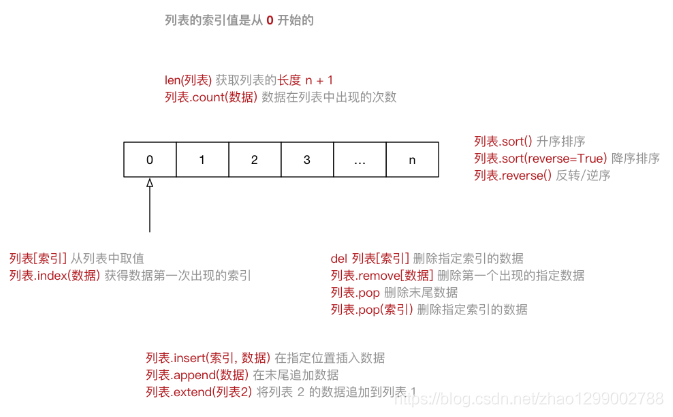
1.2 列表常用操作
- 在
ipython3中定義一個 列表,例如:name_list = [] - 輸入
name_list.按下TAB鍵,ipython會提示 列表 能夠使用的 方法 如下:
In [1]: name_list.
name_list.append name_list.count name_list.insert name_list.reverse
name_list.clear name_list.extend name_list.pop name_list.sort
name_list.copy name_list.index name_list.remove
| 序號 | 分類 | 關鍵字 / 函數 / 方法 | 說明 |
|---|---|---|---|
| 1 | 增加 | 列表.insert(索引, 數據) | 在指定位置插入數據 |
| 列表.append(數據) | 在末尾追加數據 | ||
| 列表.extend(列表2) | 將列表2 的數據追加到列表 | ||
| 2 | 修改 | 列表[索引] = 數據 | 修改指定索引的數據 |
| 3 | 刪除 | del 列表[索引] | 刪除指定索引的數據 |
| 列表.remove[數據] | 刪除第一個出現的指定數據 | ||
| 列表.pop | 刪除末尾數據 | ||
| 列表.pop(索引) | 刪除指定索引數據 | ||
| 列表.clear | 清空列表 | ||
| 4 | 統計 | len(列表) | 列表長度 |
| 列表.count(數據) | 數據在列表中出現的次數 | ||
| 5 | 排序 | 列表.sort() | 升序排序 |
| 列表.sort(reverse=True) | 降序排序 | ||
| 列表.reverse() | 逆序、反轉 |
del 關鍵字(科普)
- 使用
del關鍵字(delete) 同樣可以刪除列表中元素 del關鍵字本質上是用來 將一個變數從記憶體中刪除的- 如果使用
del關鍵字將變數從記憶體中刪除,後續的程式碼就不能再使用這個變數了
del name_list[1]
在日常開發中,要從列表刪除數據,建議 使用列表提供的方法
關鍵字、函數和方法(科普)
- 關鍵字 是 Python 內建的、具有特殊意義的識別符號
In [1]: import keyword
In [2]: print(keyword.kwlist)
In [3]: print(len(keyword.kwlist))
關鍵字後面不需要使用括號
- 函數 封裝了獨立功能,可以直接呼叫
函數名(參數)
函數需要死記硬背
- 方法 和函數類似,同樣是封裝了獨立的功能
- 方法 需要通過 物件 來呼叫,表示針對這個 物件 要做的操作
物件.方法名(參數)
在變數後面輸入
.,然後選擇針對這個變數要執行的操作,記憶起來比函數要簡單很多
1.3 回圈遍歷
-
遍歷 就是 從頭到尾 依次 從 列表 中獲取數據
- 在 回圈體內部 針對 每一個元素,執行相同的操作
-
在
Python中爲了提高列表的遍歷效率,專門提供的 迭代 iteration 遍歷 -
使用
for就能夠實現迭代遍歷
# for 回圈內部使用的變數 in 列表
for name in name_list:
回圈內部針對列表元素進行操作
print(name)
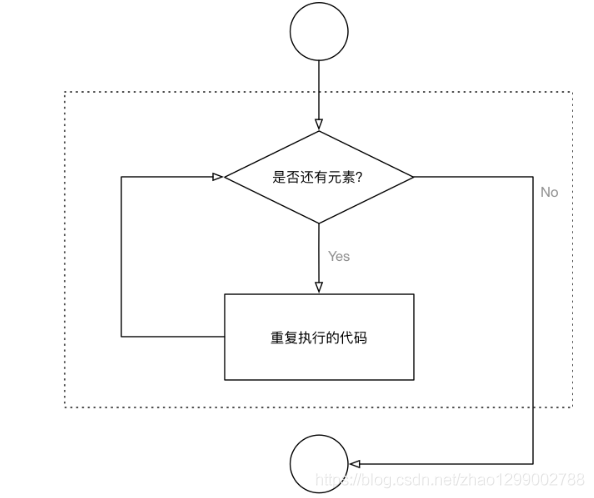
1.4 應用場景
- 儘管
Python的 列表 中可以 儲存不同類型的數據 - 但是在開發中,更多的應用場景是
- 列表 儲存相同類型的數據
- 通過 迭代遍歷,在回圈體內部,針對列表中的每一項元素,執行相同的操作
02. 元組
2.1 元組的定義
Tuple(元組)與列表類似,不同之處在於元組的 元素不能修改- 元組 表示多個元素組成的序列
- 元組 在
Python開發中,有特定的應用場景
- 用於儲存 一串 資訊,數據 之間使用
,分隔 - 元組用
()定義 - 元組的 索引 從
0開始- 索引 就是數據在 元組 中的位置編號
info_tuple = ("zhangsan", 18, 1.75)
建立空元組
info_tuple = ()
元組中 只包含一個元素 時,需要 在元素後面新增逗號
info_tuple = (50, )
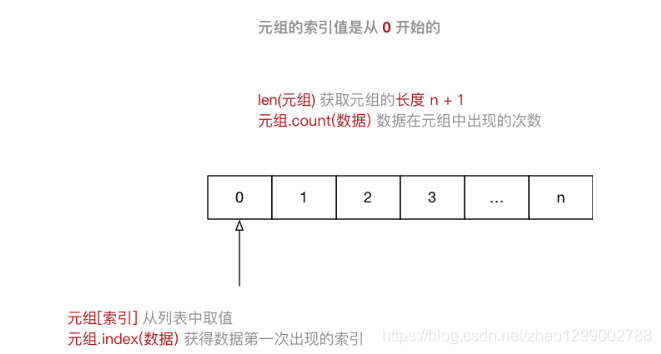
2.2 元組常用操作
- 在
ipython3中定義一個 元組,例如:info = () - 輸入
info.按下TAB鍵,ipython會提示 元組 能夠使用的函數如下:
info.count info.index
有關 元組 的 常用操作 可以參照上圖練習
2.3 回圈遍歷
- 取值 就是從 元組 中獲取儲存在指定位置的數據
- 遍歷 就是 從頭到尾 依次 從 元組 中獲取數據
# for 回圈內部使用的變數 in 元組
for item in info:
回圈內部針對元組元素進行操作
print(item)
- 在
Python中,可以使用for回圈遍歷所有非數位型型別的變數:列表、元組、字典 以及 字串- 提示:在實際開發中,除非 能夠確認元組中的數據型別,否則針對元組的回圈遍歷需求並不是很多
2.4 應用場景
- 儘管可以使用
for in遍歷 元組 - 但是在開發中,更多的應用場景是:
- 函數的 參數 和 返回值,一個函數可以接收 任意多個參數,或者 一次返回多個數據
- 有關 函數的參數 和 返回值,在後續 函數高階 給大家介紹
- 格式字串,格式化字串後面的
()本質上就是一個元組 - 讓列表不可以被修改,以保護數據安全
- 函數的 參數 和 返回值,一個函數可以接收 任意多個參數,或者 一次返回多個數據
info = ("zhangsan", 18)
print("%s 的年齡是 %d" % info)
元組和列表之間的轉換
- 使用
list函數可以把元組轉換成列表
list(元組)
- 使用
tuple函數可以把列錶轉換成元組
tuple(列表)
03. 字典
3.1 字典的定義
dictionary(字典) 是 除列表以外Python之中 最靈活 的數據型別- 字典同樣可以用來 儲存多個數據
- 通常用於儲存 描述一個
物體的相關資訊
- 通常用於儲存 描述一個
- 和列表的區別
- 列表 是 有序 的物件集合
- 字典 是 無序 的物件集合
- 字典用
{}定義 - 字典使用 鍵值對 儲存數據,鍵值對之間使用
,分隔- 鍵
key是索引 - 值
value是數據 - 鍵 和 值 之間使用
:分隔 - 鍵必須是唯一的
- 值 可以取任何數據型別,但 鍵 只能使用 字串、數位或 元組
- 鍵
xiaoming = {"name": "小明",
"age": 18,
"gender": True,
"height": 1.75}
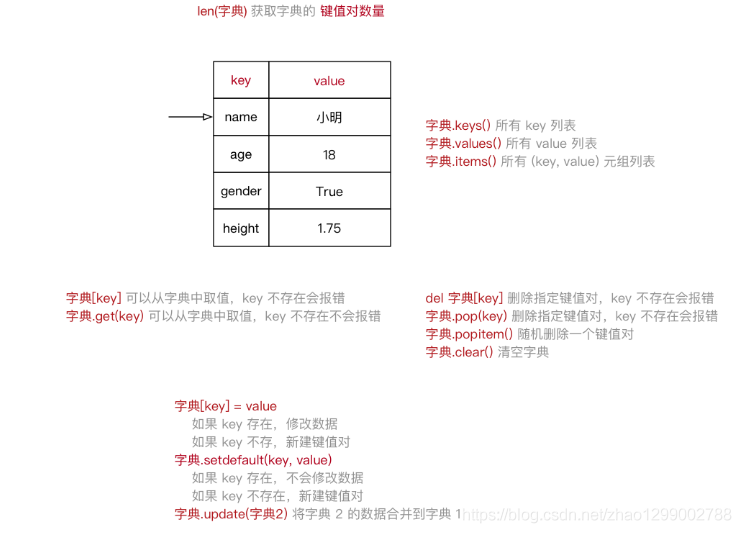
3.2 字典常用操作
- 在
ipython3中定義一個 字典,例如:xiaoming = {} - 輸入
xiaoming.按下TAB鍵,ipython會提示 字典 能夠使用的函數如下:
In [1]: xiaoming.
xiaoming.clear xiaoming.items xiaoming.setdefault
xiaoming.copy xiaoming.keys xiaoming.update
xiaoming.fromkeys xiaoming.pop xiaoming.values
xiaoming.get xiaoming.popitem
有關 字典 的 常用操作 可以參照上圖練習
3.3 回圈遍歷
- 遍歷 就是 依次 從 字典 中獲取所有鍵值對
# for 回圈內部使用的 `key 的變數` in 字典
for k in xiaoming:
print("%s: %s" % (k, xiaoming[k]))
提示:在實際開發中,由於字典中每一個鍵值對儲存數據的型別是不同的,所以針對字典的回圈遍歷需求並不是很多
3.4 應用場景
- 儘管可以使用
for in遍歷 字典 - 但是在開發中,更多的應用場景是:
- 使用 多個鍵值對,儲存 描述一個
物體的相關資訊 —— 描述更復雜的數據資訊 - 將 多個字典 放在 一個列表 中,再進行遍歷,在回圈體內部針對每一個字典進行 相同的處理
- 使用 多個鍵值對,儲存 描述一個
card_list = [{"name": "張三",
"qq": "12345",
"phone": "110"},
{"name": "李四",
"qq": "54321",
"phone": "10086"}
]
04. 字串
4.1 字串的定義
- 字串 就是 一串字元,是程式語言中表示文字的數據型別
- 在 Python 中可以使用 一對雙引號
"或者 一對單引號'定義一個字串- 雖然可以使用
\"或者\'做字串的跳脫,但是在實際開發中:- 如果字串內部需要使用
",可以使用'定義字串 - 如果字串內部需要使用
',可以使用"定義字串
- 如果字串內部需要使用
- 雖然可以使用
- 可以使用 索引 獲取一個字串中 指定位置的字元,索引計數從 0 開始
- 也可以使用
for回圈遍歷 字串中每一個字元
大多數程式語言都是用
"來定義字串
string = "Hello Python"
for c in string:
print(c)
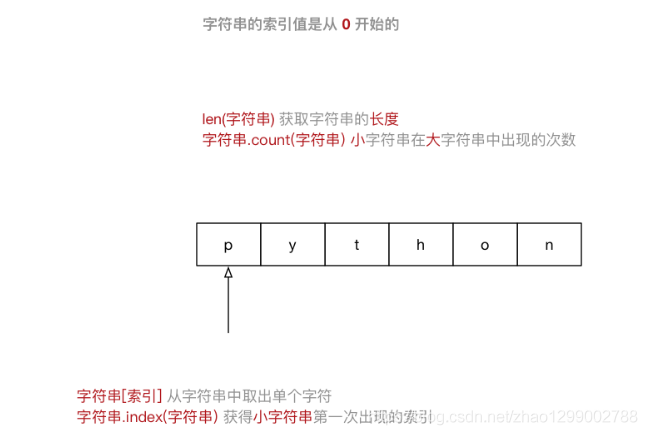
4.2 字串的常用操作
- 在
ipython3中定義一個 字串,例如:hello_str = "" - 輸入
hello_str.按下TAB鍵,ipython會提示 字串 能夠使用的 方法 如下:
In [1]: hello_str.
hello_str.capitalize hello_str.isidentifier hello_str.rindex
hello_str.casefold hello_str.islower hello_str.rjust
hello_str.center hello_str.isnumeric hello_str.rpartition
hello_str.count hello_str.isprintable hello_str.rsplit
hello_str.encode hello_str.isspace hello_str.rstrip
hello_str.endswith hello_str.istitle hello_str.split
hello_str.expandtabs hello_str.isupper hello_str.splitlines
hello_str.find hello_str.join hello_str.startswith
hello_str.format hello_str.ljust hello_str.strip
hello_str.format_map hello_str.lower hello_str.swapcase
hello_str.index hello_str.lstrip hello_str.title
hello_str.isalnum hello_str.maketrans hello_str.translate
hello_str.isalpha hello_str.partition hello_str.upper
hello_str.isdecimal hello_str.replace hello_str.zfill
hello_str.isdigit hello_str.rfind
提示:正是因爲 python 內建提供的方法足夠多,才使得在開發時,能夠針對字串進行更加靈活的操作!應對更多的開發需求!
1) 判斷型別 - 9
| 方法 | 說明 |
|---|---|
| string.isspace() | 如果 string 中只包含空格,則返回 True |
| string.isalnum() | 如果 string 至少有一個字元並且所有字元都是字母或數位則返回 True |
| string.isalpha() | 如果 string 至少有一個字元並且所有字元都是字母則返回 True |
| string.isdecimal() | 如果 string 只包含數位則返回 True,全形數位 |
| string.isdigit() | 如果 string 只包含數位則返回 True,全形數位、⑴、\u00b2 |
| string.isnumeric() | 如果 string 只包含數位則返回 True,全形數位,漢字數位 |
| string.istitle() | 如果 string 是標題化的(每個單詞的首字母大寫)則返回 True |
| string.islower() | 如果 string 中包含至少一個區分大小寫的字元,並且所有這些(區分大小寫的)字元都是小寫,則返回 True |
| string.isupper() | 如果 string 中包含至少一個區分大小寫的字元,並且所有這些(區分大小寫的)字元都是大寫,則返回 True |
2) 查詢和替換 - 7
| 方法 | 說明 |
|---|---|
| string.startswith(str) | 檢查字串是否是以 str 開頭,是則返回 True |
| string.endswith(str) | 檢查字串是否是以 str 結束,是則返回 True |
| string.find(str, start=0, end=len(string)) | 檢測 str 是否包含在 string 中,如果 start 和 end 指定範圍,則檢查是否包含在指定範圍內,如果是返回開始的索引值,否則返回 -1 |
| string.rfind(str, start=0, end=len(string)) | 類似於 find(),不過是從右邊開始查詢 |
| string.index(str, start=0, end=len(string)) | 跟 find() 方法類似,不過如果 str 不在 string 會報錯 |
| string.rindex(str, start=0, end=len(string)) | 類似於 index(),不過是從右邊開始 |
| string.replace(old_str, new_str, num=string.count(old)) | 把 string 中的 old_str 替換成 new_str,如果 num 指定,則替換不超過 num 次 |
3) 大小寫轉換 - 5
| 方法 | 說明 |
|---|---|
| string.capitalize() | 把字串的第一個字元大寫 |
| string.title() | 把字串的每個單詞首字母大寫 |
| string.lower() | 轉換 string 中所有大寫字元爲小寫 |
| string.upper() | 轉換 string 中的小寫字母爲大寫 |
| string.swapcase() | 翻轉 string 中的大小寫 |
4) 文字對齊 - 3
| 方法 | 說明 |
|---|---|
| string.ljust(width) | 返回一個原字串左對齊,並使用空格填充至長度 width 的新字串 |
| string.rjust(width) | 返回一個原字串右對齊,並使用空格填充至長度 width 的新字串 |
| string.center(width) | 返回一個原字串居中,並使用空格填充至長度 width 的新字串 |
5) 去除空白字元 - 3
| 方法 | 說明 |
|---|---|
| string.lstrip() | 截掉 string 左邊(開始)的空白字元 |
| string.rstrip() | 截掉 string 右邊(末尾)的空白字元 |
| string.strip() | 截掉 string 左右兩邊的空白字元 |
6) 拆分和連線 - 5
| 方法 | 說明 |
|---|---|
| string.partition(str) | 把字串 string 分成一個 3 元素的元組 (str前面, str, str後面) |
| string.rpartition(str) | 類似於 partition() 方法,不過是從右邊開始查詢 |
| string.split(str="", num) | 以 str 爲分隔符拆分 string,如果 num 有指定值,則僅分隔 num + 1 個子字串,str 預設包含 ‘\r’, ‘\t’, ‘\n’ 和空格 |
| string.splitlines() | 按照行(’\r’, ‘\n’, ‘\r\n’)分隔,返回一個包含各行作爲元素的列表 |
| string.join(seq) | 以 string 作爲分隔符,將 seq 中所有的元素(的字串表示)合併爲一個新的字串 |
4.3 字串的切片
- 切片 方法適用於 字串、列表、元組
- 切片 使用 索引值 來限定範圍,從一個大的 字串 中 切出 小的 字串
- 列表 和 元組 都是 有序 的集合,都能夠 通過索引值 獲取到對應的數據
- 字典 是一個 無序 的集合,是使用 鍵值對 儲存數據
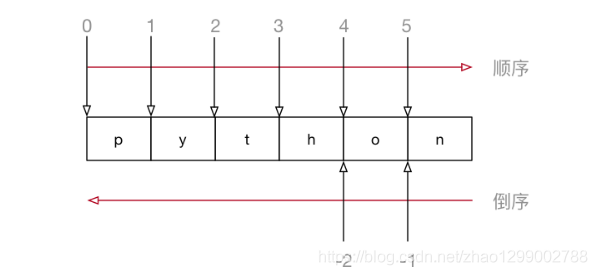
字串[開始索引:結束索引:步長]
注意:
- 指定的區間屬於 左閉右開 型
[開始索引, 結束索引)=>開始索引 >= 範圍 < 結束索引- 從
起始位開始,到結束位的前一位 結束(不包含結束位本身)
- 從
- 從頭開始,開始索引 數位可以省略,冒號不能省略
- 到末尾結束,結束索引 數位可以省略,冒號不能省略
- 步長預設爲
1,如果連續切片,數位和冒號都可以省略
索引的順序和倒序
- 在 Python 中不僅支援 順序索引,同時還支援 倒序索引
- 所謂倒序索引就是 從右向左 計算索引
- 最右邊的索引值是 -1,依次遞減
演練需求
-
- 擷取從 2 ~ 5 位置 的字串
-
- 擷取從 2 ~
末尾的字串
- 擷取從 2 ~
-
- 擷取從
開始~ 5 位置 的字串
- 擷取從
-
- 擷取完整的字串
-
- 從開始位置,每隔一個字元擷取字串
-
- 從索引 1 開始,每隔一個取一個
-
- 擷取從 2 ~
末尾 - 1的字串
- 擷取從 2 ~
-
- 擷取字串末尾兩個字元
-
- 字串的逆序(面試題)
答案
num_str = "0123456789"
# 1. 擷取從 2 ~ 5 位置 的字串
print(num_str[2:6])
# 2. 擷取從 2 ~ `末尾` 的字串
print(num_str[2:])
# 3. 擷取從 `開始` ~ 5 位置 的字串
print(num_str[:6])
# 4. 擷取完整的字串
print(num_str[:])
# 5. 從開始位置,每隔一個字元擷取字串
print(num_str[::2])
# 6. 從索引 1 開始,每隔一個取一個
print(num_str[1::2])
# 倒序切片
# -1 表示倒數第一個字元
print(num_str[-1])
# 7. 擷取從 2 ~ `末尾 - 1` 的字串
print(num_str[2:-1])
# 8. 擷取字串末尾兩個字元
print(num_str[-2:])
# 9. 字串的逆序(面試題)
print(num_str[::-1])
05. 公共方法
5.1 Python 內建函數
Python 包含了以下內建函數:
| 函數 | 描述 | 備註 |
|---|---|---|
| len(item) | 計算容器中元素個數 | |
| del(item) | 刪除變數 | del 有兩種方式 |
| max(item) | 返回容器中元素最大值 | 如果是字典,只針對 key 比較 |
| min(item) | 返回容器中元素最小值 | 如果是字典,只針對 key 比較 |
| cmp(item1, item2) | 比較兩個值,-1 小於/0 相等/1 大於 | Python 3.x 取消了 cmp 函數 |
注意
- 字串 比較符合以下規則: 「0」 < 「A」 < 「a」
5.2 切片
| 描述 | Python 表達式 | 結果 | 支援的數據型別 |
|---|---|---|---|
| 切片 | 「0123456789」[::-2] | 「97531」 | 字串、列表、元組 |
- 切片 使用 索引值 來限定範圍,從一個大的 字串 中 切出 小的 字串
- 列表 和 元組 都是 有序 的集合,都能夠 通過索引值 獲取到對應的數據
- 字典 是一個 無序 的集合,是使用 鍵值對 儲存數據
5.3 運算子
| 運算子 | Python 表達式 | 結果 | 描述 | 支援的數據型別 |
|---|---|---|---|---|
| + | [1, 2] + [3, 4] | [1, 2, 3, 4] | 合併 | 字串、列表、元組 |
| * | [「Hi!」] * 4 | [‘Hi!’, ‘Hi!’, ‘Hi!’, ‘Hi!’] | 重複 | 字串、列表、元組 |
| in | 3 in (1, 2, 3) | True | 元素是否存在 | 字串、列表、元組、字典 |
| not in | 4 not in (1, 2, 3) | True | 元素是否不存在 | 字串、列表、元組、字典 |
| > >= == < <= | (1, 2, 3) < (2, 2, 3) | True | 元素比較 | 字串、列表、元組 |
注意
in在對 字典 操作時,判斷的是 字典的鍵in和not in被稱爲 成員運算子
成員運算子
成員運算子用於 測試 序列中是否包含指定的 成員
| 運算子 | 描述 | 範例 |
|---|---|---|
| in | 如果在指定的序列中找到值返回 True,否則返回 False | 3 in (1, 2, 3) 返回 True |
| not in | 如果在指定的序列中沒有找到值返回 True,否則返回 False | 3 not in (1, 2, 3) 返回 False |
注意:在對 字典 操作時,判斷的是 字典的鍵
5.4 完整的 for 回圈語法
- 在
Python中完整的for 回圈的語法如下:
for 變數 in 集合:
回圈體程式碼
else:
沒有通過 break 退出回圈,回圈結束後,會執行的程式碼
應用場景
- 在 迭代遍歷 巢狀的數據型別時,例如 一個列表包含了多個字典
- 需求:要判斷 某一個字典中 是否存在 指定的 值
- 如果 存在,提示並且退出回圈
- 如果 不存在,在 回圈整體結束 後,希望 得到一個統一的提示
students = [
{"name": "阿土",
"age": 20,
"gender": True,
"height": 1.7,
"weight": 75.0},
{"name": "小美",
"age": 19,
"gender": False,
"height": 1.6,
"weight": 45.0},
]
find_name = "阿土"
for stu_dict in students:
print(stu_dict)
# 判斷當前遍歷的字典中姓名是否爲find_name
if stu_dict["name"] == find_name:
print("找到了")
# 如果已經找到,直接退出回圈,就不需要再對後續的數據進行比較
break
else:
print("沒有找到")
print("回圈結束")